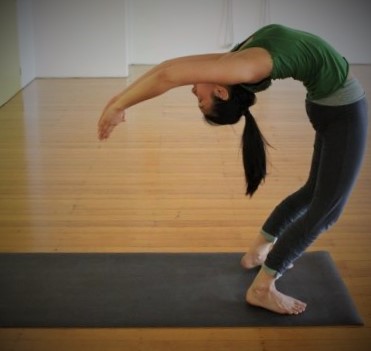We all know we should stretch every hour while we’re at work, but how many of us actually do it? Every morning, you sit down at your desk with the greatest intention of stretching regularly or at least getting up to move around a bit. Five hours later… you realise that you haven’t moved an inch and you’re hunched over your desk with a sore lower back and stiff shoulders/neck that have knots so hard you’re surprised you can still turn your head. I’m definitely guilty of this!
Here is a short, easy sequence to help stretch out those kinks in your neck and shoulders. The great thing about this sequence is that you can do it at your desk or while waiting for the bus, the kettle to boil or in line at the post shop: these basic stretches come so naturally that you won’t get too many strange looks in public! You also don't need any props, not even a yoga mat.
The trick to remembering this sequence is – forwards, backwards, side-to-side, twist – the six basic movements in yoga.
Forwards, backwards, side-to-side, twist
Short version
Forwards: Interlace your hands behind your head, with your elbows pointing forward, and slowly stretch out the back of the neck, bringing your chin towards your chest for 5–10 deep breaths.
Backwards: Interlace your hands behind your back and press your hands away from your back. Lift your chin up and stay here for 5–10 deep breaths.
Side to side: Catching the left side of your head, gently tilting your head to the right for 5–10 deep breaths. Bring your chin towards your right collarbone, looking at your right shoulder, for another 5 breaths. Release and repeat on the other side.
Twist: Twist to the right, from the base of your spine right up to the top of your neck. Look over your right shoulder for 5–10 deep breaths. Release and repeat on the other side.
Full description
Forward: Interlace your hands behind your head, with your elbows pointing forward. Sit up straight and engage your core muscles (lower abdominal muscles drawing in and up) throughout this sequence. Now let your elbows come forward and down, allowing the weight of your arms to stretch out the back of your neck. Don’t press down just yet – let the tension at the base of your neck slowly melt away. Once you’ve been here for a few deep breaths, if you feel like you want a little more stretch, you can start to press down a little on the back of your head, bringing your chin a little closer to your chest. Let your shoulders relax down away from your ears, and lift your chest upward towards your chin. Stay here for 5–10 deep breaths. Slowly release your hands and bring your head back up.
Back: Now let’s do the opposite and stretch out the front of your neck. Interlace your hands behind your back and, if possible, straighten your arms and press your palms together. Lift your chin up, looking up at the ceiling (if this hurts your neck, ease off a bit and focus on lifting your forehead and chin equally while drawing your shoulders down). Keep opening your chest by slightly squeezing your shoulder blades together and sliding them down the back. Stay here for 5–10 deep breaths. If you’re standing, you can even do a slight backbend by pressing your hips forward with your feet hip-width apart. Slowly bring your chin back down to level and release your hands.
Side-to-side: Now let’s stretch out each side of your neck. Reach your right arm over your head, catch the left side of your head and tilt your head to the right. Keep the rest of your spine straight and long. Actively draw both shoulders down away from your ears. Again, start slowly – you can add more weight once you feel the release on the left side of your neck. Keep breathing deeply, feeling your rib cage stretching out on all sides of your body – front, sides, back, all the way up to your collarbones. Shallow breathing is a very common issue that can exacerbate anxiety and stress, so while you’re paying attention to your body, you may as well stretch out your lungs as well as your muscles. Stay here for 5–10 deep breaths.
Now bring your chin towards your collarbone, looking at your right shoulder for another 5 deep breaths. Lift up from your chest every time you breathe in and actively draw your left shoulder down. Slowly release and repeat on the other side.
Twist: Sit close to the front edge of your chair and sit up tall, imagining your spine getting longer. Keep drawing your shoulders back and down, and twist to the right from the base of your spine all the way up to the top of your neck, slightly squeezing your knees together. Catch the outside of your right knee with your left hand and bring your right hand behind you on your chair. Try to point your right shoulder directly behind you and look over your shoulder. With each inhalation, lengthen your spine; with each exhalation, twist deeper. Stay here for 5–10 deep breathes, then release and repeat on the other side.
Give this sequence a try at work today – let me know how it goes!







